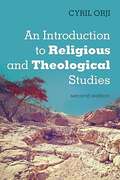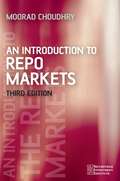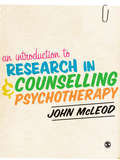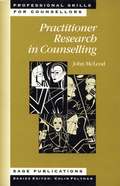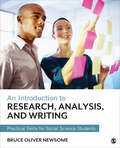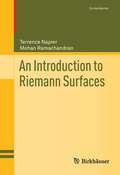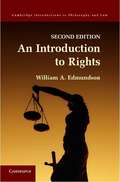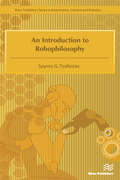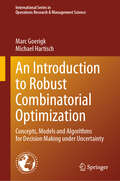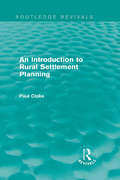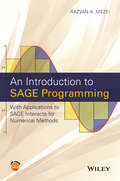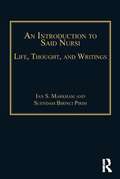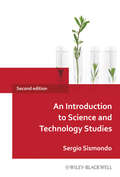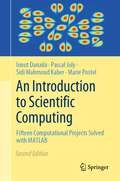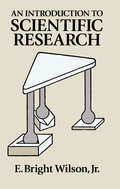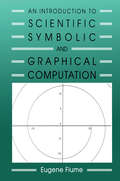- Table View
- List View
An Introduction to Religious and Theological Studies
by Cyril OrjiAn Introduction to Religious and Theological Studies walks students through topical issues to be encountered in the study of the Abrahamic religions: Judaism, Christianity, and Islam as these religions encounter other religions in the context of the wider ecumenism. The text is written from a Christian point of view and aims at helping students understand that to be Christian is to be ecumenical. African Traditional Religions (ATRs) has been included in this survey to provide background for the religious traditions and cultures of peoples of Africa as Christianity moves inexorably southward. The book has been written with undergraduate general education students in mind—including meeting the needs of those in seminaries and theological institutes.
An Introduction to Repo Markets
by Moorad ChoudhryThe Repo markets have grown dramatically in the past few years because of the need to hedge short positions in the capital and derivatives markets. Virtually all major currency markets in the world now have an established repo market, the facility is also increasingly being used in developing currency markets as well.This book is a practical introduction that focuses on the instruments, applications and risk management techniques essential for this rapidly evolving market. Fully updated to reflect the changes in these markets, the book also includes worked examples and case studies, and new sections on basket and structured finance repo.
An Introduction to Research in Counselling and Psychotherapy
by John McLeodIntroducing the basic principles of research theory and practice, this book is the ideal starter text for any counselling trainee or practitioner learning about the research process for the first time. Structured around common training topics, the book: - Explains why you need to do research at all: what it is, why it's important and its historical and philosophical context - Guides you through the confusing mass of research literature - Covers the ins and outs of actually doing research: practical and ethical issues - Helps you get the most out of research - how to evaluate the outcomes and use research to investigate the process of therapy. Written in a language familiar to first-year trainees and using a range of features to enhance learning, this accessible introduction will equip both trainees and qualified therapists with the essential nuts and bolts to understand research. John McLeod is Emeritus Professor of Counselling at the University of Abertay Dundee and adjunct Professor at the University of Oslo, Norway.
An Introduction to Research in Counselling and Psychotherapy (Professional Skills for Counsellors Series)
by John McleodIntroducing the basic principles of research theory and practice, this book is the ideal starter text for any counselling trainee or practitioner learning about the research process for the first time. Structured around common training topics, the book: - Explains why you need to do research at all: what it is, why it's important and its historical and philosophical context - Guides you through the confusing mass of research literature - Covers the ins and outs of actually doing research: practical and ethical issues - Helps you get the most out of research - how to evaluate the outcomes and use research to investigate the process of therapy. Written in a language familiar to first-year trainees and using a range of features to enhance learning, this accessible introduction will equip both trainees and qualified therapists with the essential nuts and bolts to understand research. John McLeod is Emeritus Professor of Counselling at the University of Abertay Dundee and adjunct Professor at the University of Oslo, Norway.
An Introduction to Research, Analysis, and Writing: Practical Skills for Social Science Students
by Bruce Oliver NewsomeThis accessible guide walks readers through the process of completing a social science research project. Written specifically to meet the needs of undergraduate research classes, it introduces students to a complete skill set, including: planning, design, analysis, argumentation, criticizing theories, building theories, modeling theories, choosing methods, gathering data, presenting evidence, and writing the final product. Students can use this text as a practical resource to navigate through each stage of the process, including choices between more advanced research techniques.
An Introduction to Research, Analysis, and Writing: Practical Skills for Social Science Students
by Bruce Oliver NewsomeThis accessible guide walks readers through the process of completing a social science research project. Written specifically to meet the needs of undergraduate research classes, it introduces students to a complete skill set, including: planning, design, analysis, argumentation, criticizing theories, building theories, modeling theories, choosing methods, gathering data, presenting evidence, and writing the final product. Students can use this text as a practical resource to navigate through each stage of the process, including choices between more advanced research techniques.
An Introduction to Reservoir Simulation Using MATLAB/GNU Octave: User Guide for the MATLAB Reservoir Simulation Toolbox (MRST)
by Knut-Andreas LieThis book provides a self-contained introduction to the simulation of flow and transport in porous media, written by a developer of numerical methods. The reader will learn how to implement reservoir simulation models and computational algorithms in a robust and efficient manner. The book contains a large number of numerical examples, all fully equipped with online code and data, allowing the reader to reproduce results, and use them as a starting point for their own work. All of the examples in the book are based on the MATLAB Reservoir Simulation Toolbox (MRST), an open-source toolbox popular popularity in both academic institutions and the petroleum industry. The book can also be seen as a user guide to the MRST software. It will prove invaluable for researchers, professionals and advanced students using reservoir simulation methods. This title is also available as Open Access on Cambridge Core.
An Introduction to Riemann Surfaces (Cornerstones)
by Mohan Ramachandran Terrence NapierThis textbook presents a unified approach to compact and noncompact Riemann surfaces from the point of view of the so-called L2 $\bar{\delta}$-method. This method is a powerful technique from the theory of several complex variables, and provides for a unique approach to the fundamentally different characteristics of compact and noncompact Riemann surfaces. The inclusion of continuing exercises running throughout the book, which lead to generalizations of the main theorems, as well as the exercises included in each chapter make this text ideal for a one- or two-semester graduate course.
An Introduction to Riemannian Geometry: With Applications to Mechanics and Relativity (Universitext)
by Leonor Godinho José NatárioUnlike many other texts on differential geometry, this textbook also offers interesting applications to geometric mechanics and general relativity. The first part is a concise and self-contained introduction to the basics of manifolds, differential forms, metrics and curvature. The second part studies applications to mechanics and relativity including the proofs of the Hawking and Penrose singularity theorems. It can be independently used for one-semester courses in either of these subjects. The main ideas are illustrated and further developed by numerous examples and over 300 exercises. Detailed solutions are provided for many of these exercises, making An Introduction to Riemannian Geometry ideal for self-study.
An Introduction to Rights
by William A. EdmundsonAn Introduction to Rights is a readable and accessible introduction to the history, logic, moral implications, and political tendencies of the idea of rights. It is organized chronologically and discusses important historical events such as the French and American Revolutions. It treats a range of historical figures, including Grotius, Paley, Hobbes, Locke, Bentham, Burke, Godwin, Douglass, Mill, and Hohfeld, and relates the concept of rights to contemporary debates such as consequentialism versus contractualism. This thoroughly updated second edition includes a new preface and expands the discussion of the surprising role that slavery has played in the history of rights. It includes new material on egalitarianism, distributive justice, and what the demand for equal rights means.
An Introduction to Robophilosophy Cognition, Intelligence, Autonomy, Consciousness, Conscience, and Ethics: Cognition, Intelligence, Autonomy, Consciousness, Conscience And Ethics (River Publishers Series In Automation, Control, And Robotics Is A Series Of Comprehensive Academic And Professional Books Which Focus On The Theory And Applications Of Automation, Control And Robotics. The Series Focuses On Topics Ranging From The Theory And Use Of Control Systems, Automation Engineering, Robotics And Intelligent Machines. Books Published In The Series Include Research Monographs,)
by Spyros G. TzafestasModern robots have arrived at a very matured state both in their mechanical / control aspects and their mental aspects. An Introduction to Robophilosophy explores the philosophical questions that arise in the development, creation, and use of mental – anthropomorphic and zoomorphic- robots that are capable of semiautonomous / autonomous operation, decision making and human-like action, being able to socially interact with humans and exhibit behavior similar to human beings or animals. Coverage first presents fundamental concepts, and an overview of philosophy, philosophy of science, and philosophy of technology. The six principal mental capabilities of modern robots, namely cognition, intelligence, autonomy, consciousness, conscience, and ethics are then studied from a philosophical point of view. They actually represent the product of technological embodiment of cognitive features to robots. Overall, readers are provided a consolidated thorough investigation of the philosophical aspects of these mental capabilities when embedded to robots. This book will serve as an ideal educational source in engineering and robotics courses as well as an introductory reference for researchers in the field of robotics, and it includes a rich bibliography.
An Introduction to Robust Combinatorial Optimization: Concepts, Models and Algorithms for Decision Making under Uncertainty (International Series in Operations Research & Management Science #361)
by Michael Hartisch Marc GoerigkThis book offers a self-contained introduction to the world of robust combinatorial optimization. It explores decision-making using the min-max and min-max regret criteria, while also delving into the two-stage and recoverable robust optimization paradigms. It begins by introducing readers to general results for interval, discrete, and budgeted uncertainty sets, and subsequently provides a comprehensive examination of specific combinatorial problems, including the selection, shortest path, spanning tree, assignment, knapsack, and traveling salesperson problems. The book equips both students and newcomers to the field with a grasp of the fundamental questions and ongoing advancements in robust optimization. Based on the authors’ years of teaching and refining numerous courses, it not only offers essential tools but also highlights the open questions that define this subject area.
An Introduction to Rural Settlement Planning (Routledge Revivals)
by Paul ClokeThis book, first published in 1983, provided the first thorough and informative introduction to the theory, practice and politics of rural settlement planning. It surveys the conceptual and ideological leanings of those who have developed, implemented and revised rural settlement practice, and gives detailed analysis of planning documentation to assess the extent to which policies have been successfully implemented. Paul Cloke assesses the shortfalls of rural planning and resource management and suggests methods by which a sustainable rural future might be attained. This reissue provides essential background and a comprehensive handbook for those with an interest in rural settlement planning.
An Introduction to SAGE Programming
by Razvan A. MezeiFeatures a simplified presentation of numerical methods by introducing and implementing SAGE programs An Introduction to SAGE Programming: With Applications to SAGE Interacts for Numerical Methods emphasizes how to implement numerical methods using SAGE Math and SAGE Interacts and also addresses the fundamentals of computer programming, including if statements, loops, functions, and interacts. The book also provides a unique introduction to SAGE and its computer algebra system capabilities, discusses second and higher order equations and estimate limits, and determines derivatives, integrals, and summations. Providing critical resources for developing successful interactive SAGE numerical computations, the book is accessible without delving into the mathematical rigor of numerical methods. The author illustrates the benefits of utilizing the SAGE language for calculus and the numerical analysis of various methods such as bisection methods, numerical integration, Taylor's expansions, and Newton's iterations. Providing an introduction to the terminology and concepts involved, An Introduction to SAGE Programming: With Applications to SAGE Interacts for Numerical Methods features: An introduction to computer programming using SAGE Many practical examples throughout to illustrate the application of SAGE Interacts for various numerical methods Discussions on how to use SAGE Interacts and SAGE Cloud in order to create mathematical demonstrations Numerous homework problems and exercises that allow readers to practice their programming skillset A companion website that includes related SAGE programming code and select solutions to the homework problems and exercises An Introduction to SAGE Programming: With Applications to SAGE Interacts for Numerical Methods is an ideal reference for applied mathematicians who need to employ SAGE for the study of numerical methods and analysis. The book is also an appropriate supplemental textbook for upper-undergraduate and graduate-level courses in numerical methods.
An Introduction to Safety Grounding
by Asser A. ZakySafety or protective grounding is of vital importance for the protection of individuals from electric shock and structures and industrial concerns from potentially damaging lightning and electrostatic discharges. To many electrical engineers the notion of grounding is nebulous and safety grounding is quite often confused with neutral grounding of the power supply. The main objective of this book is to give the reader a better understanding of safety grounding, why it is needed, where it is needed, and what are the requirements which must be met in order to have an effective grounding system. The text as a whole serves to provide the reader with the necessary background for a better appreciation of the various National and International Standards concerned with safety grounding. This book gives the reader a good understanding of the fundamentals of safety grounding. It is a practical guide that provides a comprehensive coverage of all types of grounding requirements and is intended for students and practicing electrical engineers alike. Summarizes the physiological effects of current on the human body and the effect of current duration Gives the various methods of measuring soil resistivity and measuring the resistance to ground of an electrode or grounding system Reviews different types of ground electrodes and the effect of their geometry and numbers on the resistance to ground Presents the components of a ground system, methods of improving soil resistivity, the types of welds and joints, the criteria for determining conductor cross-sections, galvanic corrosion, and a survey of the different grounding practices used at substations and the different types of grounding systems used for the protection of consumers Deals with electrostatic and lightning hazards that can cause serious damage and the measures used to protect against such damage Throughout the text frequent reference is made to various National and International Standards and their requirements as compliance with these standards is highly advised Asser A. Zaky, Ph.D., FIET, F.Inst.P., FIEEE, is Emeritus Professor of Electrical Engineering at University of Alexandria, Egypt.
An Introduction to Safety and Security Intelligence Science
by Bing Wang Chao WuThis book is dedicated to the introduction and research on safety and security intelligence science. It is the first time to put forward the idea of intelligence-led safety management, which demonstrates distinct interdisciplinary characteristics. It caters to the needs of safety and safety intelligence in the era of big security and big intelligence, and enhances the academic value of safety intelligence research. Whether you are engaged in practical work or scientific research on safety and intelligence, or are interested in issues about safety and intelligence, this academic book will prove to be a worthy collection.
An Introduction to Said Nursi: Life, Thought, and Writings
by Ian S. Markham Suendam Birinci PirimContemporary Islamic thinkers are often studied sociologically rather than as theologians. There are many accessible introductions to Christian theologians, but very few such studies of Islamic thinkers. This book, and this series, seeks to change this situation: offering new introductions to influential Islamic thinkers and engaging, at the level of ideas, with the rich depths of contemporary Islamic theology. This book introduces to the English-speaking world the leading modern Islamic thinker Said Nursi (1878-1960) - who has some nine million followers in modern day Turkey and around the world. After an opening chapter that provides an overview of his life, the next four chapters outline the theology of Nursi on God, the Qur'an, the West and Politics. The final section provides an invaluable resource of readings from Nursi's most important writings. Providing an introduction to a major form of Islam which is committed to non-violence, dialogue and constructive relationships with the West, this is the first student textbook to introduce a contemporary Islamic theologian in a systematic way.
An Introduction to Science and Technology Studies
by Sergio SismondoAn Introduction to Science and Technology Studies, Second Edition reflects the latest advances in the field while continuing to provide students with a road map to the complex interdisciplinary terrain of science and technology studies. Distinctive in its attention to both the underlying philosophical and sociological aspects of science and technologyExplores core topics such as realism and social construction, discourse and rhetoric, objectivity, and the public understanding of science Includes numerous empirical studies and illustrative examples to elucidate the topics discussedNow includes new material on political economies of scientific and technological knowledge, and democratizing technical decisionsOther features of the new edition include improved readability, updated references, chapter reorganization, and more material on medicine and technology
An Introduction to Scientific Computing with MATLAB® and Python Tutorials
by Sheng XuThis textbook is written for the first introductory course on scientific computing. It covers elementary numerical methods for linear systems, root finding, interpolation, numerical integration, numerical differentiation, least squares problems, initial value problems and boundary value problems. It includes short Matlab and Python tutorials to quickly get students started on programming. It makes the connection between elementary numerical methods with advanced topics such as machine learning and parallel computing. This textbook gives a comprehensive and in-depth treatment of elementary numerical methods. It balances the development, implementation, analysis and application of a fundamental numerical method by addressing the following questions. •Where is the method applied?•How is the method developed?•How is the method implemented?•How well does the method work? The material in the textbook is made as self-contained and easy-to-follow as possible with reviews and remarks. The writing is kept concise and precise. Examples, figures, paper-and-pen exercises and programming problems are deigned to reinforce understanding of numerical methods and problem-solving skills.
An Introduction to Scientific Computing: Fifteen Computational Projects Solved with MATLAB
by Ionut Danaila Pascal Joly Sidi Mahmoud Kaber Marie PostelThis book demonstrates scientific computing by presenting twelve computational projects in several disciplines including Fluid Mechanics, Thermal Science, Computer Aided Design, Signal Processing and more. Each follows typical steps of scientific computing, from physical and mathematical description, to numerical formulation and programming and critical discussion of results. The text teaches practical methods not usually available in basic textbooks: numerical checking of accuracy, choice of boundary conditions, effective solving of linear systems, comparison to exact solutions and more. The final section of each project contains the solutions to proposed exercises and guides the reader in using the MATLAB scripts available online.
An Introduction to Scientific Research
by E. Bright Wilson Jr.This book is intended to assist scientists in planning and carrying out research. However, unlike most books dealing with the scientific method, which stress its philosophical rationale, this book is written from a practical standpoint. It contains a rich legacy of principles, maxims, procedures and general techniques that have been found useful in a wide range of sciences.While much of the material is accessible to a college senior, the book is more specifically intended for students beginning research and for those more experienced research workers who wish an introduction to various topics not included in their training. Mathematical treatments have been kept as elementary as possible to make the book accessible to a broad range of scientists. Its principles and rules can be absorbed to advantage by workers in such diverse fields as agriculture, industrial and military research, biology and medicine as well as in the physical sciences.After discussing such basics as the choice and statement of a research problem and elementary scientific method, Professor Wilson offers lucid and helpful discussions of the design of experiments and apparatus, execution of experiments, analysis of experimental data, errors of measurement, numerical computation and other topics. A final chapter treats the publication of research results.Although no book can substitute for actual scientific work, this highly pragmatic compendium contains much knowledge gained the hard way through years of actual practice. Moreover, the author has illustrated the ideas discussed with as many actual examples as possible. In addition, he has included notes and references at the end of each chapter to enable readers to investigate particular topics more deeply. E. Bright Wilson, Jr. is a distinguished scientist and educator whose previous works include Molecular Vibrations and Introduction to Quantum Mechanics (with Linus Pauling). In the present book, he has distilled years of experiment and experience into an indispensable broad-based guide for any scientific worker tackling a research problem.
An Introduction to Scientific Research Methods in Geography and Environmental Studies
by Daniel R. Montello Paul Sutton"Montello and Sutton is one of the best texts I've used in seminars on research methodology. The text offers a clear balance of quantitative vs. qualitative and physical vs. human which I've found particularly valuable. The chapters on research ethics, scientific communication, information technologies and data visualization are excellent" - Kenneth E. Foote, Department of Geography, University of Colorado at Boulder This is a broad and integrative introduction to the conduct and interpretation of scientific research, covering both geography and environmental studies. Written for undergraduate and postgraduate students, it: Explains both the conceptual and the technical aspects of research, as well as all phases of the research process Combines approaches in physical geography and environmental science, human geography and human-environment relations, and geographic and environmental information techniques (such as GIS, cartography, and remote sensing) Combines natural and social scientific approaches common to subjects in geography and environmental studies Includes case studies of actual research projects to demonstrate the breadth of approaches taken It will be core reading for students studying scientific research methods in geography, environmental studies and related disciplines such as planning and earth science.
An Introduction to Scientific Research Methods in Geography and Environmental Studies
by Daniel R. Montello Paul Sutton"Covers a broad range of subjects that undergraduates in the discipline should be familiar and comfortable with upon graduation. From chapters on the scientific method and fundamental research concepts, to experimental design, sampling and statistical analysis, the text offers an excellent introduction to the key concepts of geographical research. The content is applicable for students at the beginning of their studies right through to planning and conducting dissertations. The book has also been of particular support in designing my level 1 and 2 tutorials which cover similar ground to several of the chapters." - Joseph Mallalieu, School of Geography, Leeds University "Montello and Sutton is one of the best texts I've used in seminars on research methodology. The text offers a clear balance of quantitative vs. qualitative and physical vs. human which I've found particularly valuable. The chapters on research ethics, scientific communication, information technologies and data visualization are excellent." - Kenneth E. Foote, Department of Geography, University of Colorado at Boulder This is a broad and integrative introduction to the conduct and interpretation of scientific research, covering both geography and environmental studies. Written for undergraduate and postgraduate students, it: Explains both the conceptual and the technical aspects of research, as well as all phases of the research process Combines approaches in physical geography and environmental science, human geography and human-environment relations, and geographic and environmental information techniques (such as GIS, cartography, and remote sensing) Combines natural and social scientific approaches common to subjects in geography and environmental studies Includes case studies of actual research projects to demonstrate the breadth of approaches taken It will be core reading for students studying scientific research methods in geography, environmental studies and related disciplines such as planning and earth science.
An Introduction to Scientific, Symbolic, and Graphical Computation
by Eugene FiumeThis down-to-earth introduction to computation makes use of the broad array of techniques available in the modern computing environment. A self-contained guide for engineers and other users of computational methods, it has been successfully adopted as a text in teaching the next generation of mathematicians and computer graphics majors.
An Introduction to Search Engines and Web Navigation
by Mark LeveneThis book is a second edition, updated and expanded to explain the technologies that help us find information on the web. Search engines and web navigation tools have become ubiquitous in our day to day use of the web as an information source, a tool for commercial transactions and a social computing tool. Moreover, through the mobile web we have access to the web's services when we are on the move. This book demystifies the tools that we use when interacting with the web, and gives the reader a detailed overview of where we are and where we are going in terms of search engine and web navigation technologies.
